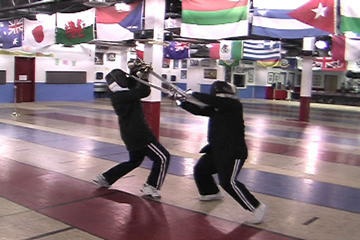
Misconceptions

Misconceptions
| About Historical Background Longsword Combat The Rise of the Rapier Misconceptions Reconstruction WMA Practice What HES Is Not Bouts Home |
One of the main reasons for the mental block people experience when trying to
imagine a European martial
art of swordfighting is the depiction of swordfighting in movies. The swashbuckling of Errol Flynn or Viggo Mortensen is dashing, but it doesn't look much like a martial art. Medieval swordfighting is generally depicted as a crude matter of swinging and
bashing, without apparent exercise of subtlety or finesse – more a matter of brute strength than skill. Contributing to this misconception is the
common myth that swords were heavy, 20-pound objects. In fact, the average longsword weighed 2.5 to 3 pounds. It generally felt even lighter in the hands because of its weight distribution (the weighted pommel brought the center of balance toward the hands, as did grooves or fullers that removed metal, thus weight, from the blade – no, they were not channels for blood). And swords were sharp – ranging from razor sharp to axe-sharp, but always able to slice through flesh and bone effectively and cleanly. Striking in a lethal manner required accuracy and control, but not speed or strength. Archaeology reveals quite vividly the deadly effectiveness of European swords: Medieval battlefields are full of skeletons whose owners died of cleanly-severed limbs. And any exercise in "test-cutting" – use of sharp steel swords on semi-hard targets like rolled tatami mats or pumpkins (see film clip) – shows that all that is required is control, not force. The mental picture of medieval fighters as brutish and unskilled is easily dispelled with just a moment's thought. Imagine living in a culture and a time when warfare was such a part of life that young men – and women (the I.33 manual depicts a woman swordfighter; and the 15th-century fechtbuch of Hans Talhoffer depicts a woman using hand-to-hand combat to defend her life in a judicial duel) – learned how to fight from an early age. There were no video games or television. Kids wrestled and fought with bare hands, they fought with sticks and staves, and they practiced swordplay both with the real thing and with purpose-built wooden practice swords (called "wasters"). Knights could afford to hire fencing teachers to train them and their children. It was a martial culture, and people knew how to fight, and to fight effectively. So the stereotypical movie image of gruff warriors trading crude blows with heavy steel crowbars is silly. Medieval society was a society of full-time and part-time martial artists, with reflexes, timing and instincts that would make a mockery of any modern practitioner. Fighting on the battlefield or the dueling ground – whether with bare hands and feet or with any of various weapons, whether in armor or just in everyday clothing – would have been fast, precise, and beautiful, something rather awe-inspiring to see. (Much more like Bruce Lee than, say, Viggo Mortensen.) Next page: Historical Reconstruction |
All material copyright 2005
Eric Wargo